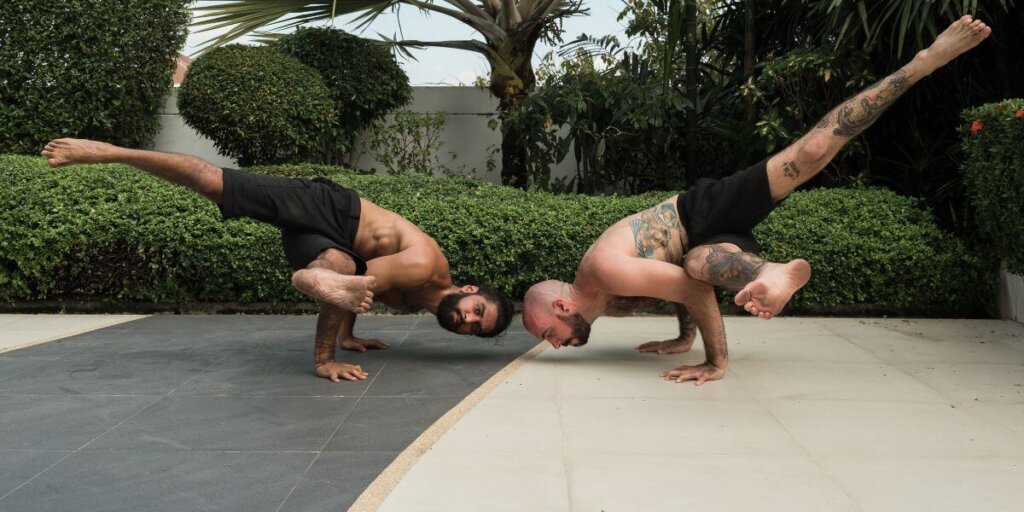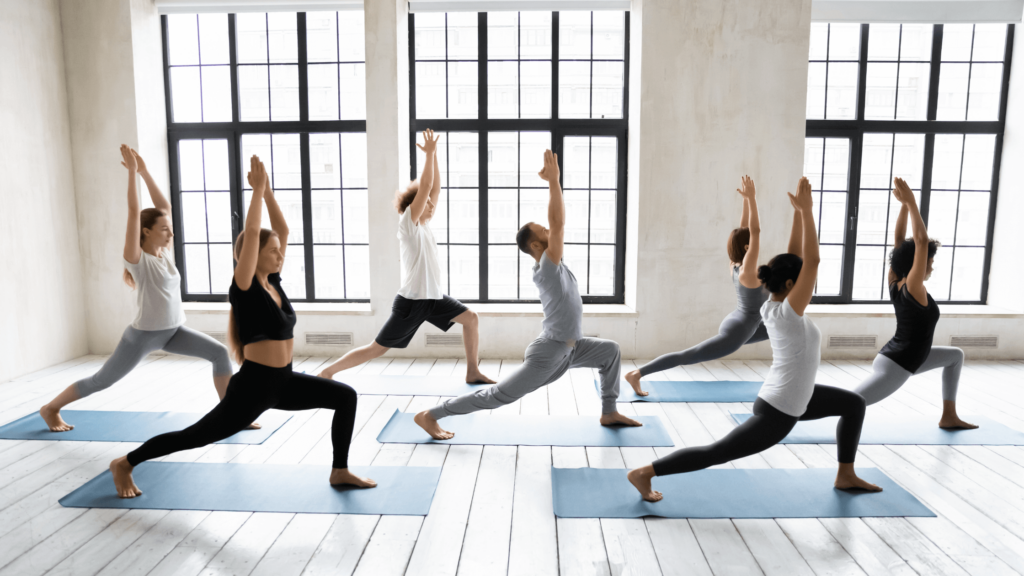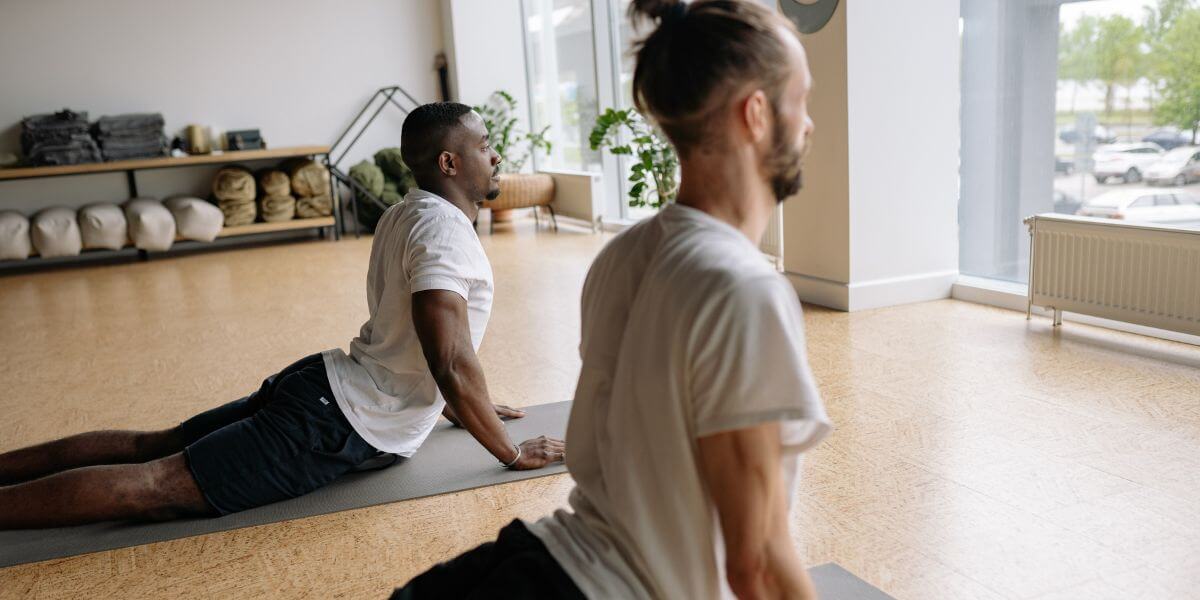Construction professionals know the importance of staying in top shape, mentally and physically. Keeping your mind and body healthy enhances performance, boosts focus, and reduces the risk of injury. One highly effective way to do that is through yoga—an ancient practice that promotes control over the body and mind through movement. But before you write yoga off as a “treehugger” practice, consider this: Yoga increases strength, improves flexibility, reduces the chances of injury, and is known to improve mood—all things a construction professional can benefit from.
Quick look
- Major benefits from regular yoga practice include improved strength and flexibility, better foot mobility, open hips, less body pain, better balance, and improved mood.
- Some of the most popular types of yoga are power, ashtanga, yin, vinyasa, hatha, and kundalini.
- Yoga will burn fat more effectively than cardio training alone, but if your goal is to increase muscle mass, working in strength training is your best bet.
- Options for getting started include free classes on YouTube, trials at your local studio, free yoga at park events, or even getting your employers to organize a corporate yoga class at your job site.

The age-old practice
Yoga is an ancient meditative practice that promotes mental and physical wellness through movement, breathing techniques, and sometimes chanting. Originating from India over 5,000 years ago, there are several types of practices and disciplines people take part in today.
When practiced regularly, yoga comes with a range of health benefits, including strength, endurance, flexibility, calmness, and mental well-being. It’s a popular form of exercise worldwide, with one in seven adults having practiced at least once per year.
While some users participate for the exercise aspect, others practice for mental relaxation, helping them wind down to promote better sleep. Construction workers are familiar with long shifts and physically demanding work, which means most people need something to counteract the effects of physical and mental stress. So whether you’re in it for the mental or physical benefits, you’ll likely experience both and feel better long term.
7 benefits of regular yoga sessions
For strenuous hours on the job, your body and mind need to withstand a lot. Here’s how regular yoga can help.
1. Better shoulder mobility
Working in the trades often means you suffer from tight pecs, hunched shoulders, stiff necks, and sometimes upper back pain. Chronic tightness in your shoulders stirs up these injuries, but working on shoulder mobility can put you back on the path to healing them.
Stretching your shoulders and neck with simple stretches like “thread the needle” or a “side neck pull” gradually improves your range of motion (ROM), making shoulder rotation easier and releasing tension. The benefits for your neck, traps, chest, and back compound.
2. Increased strength
If you’ve ever thought yoga looked slow and easy, you might be surprised to learn it’s great for building strength. Many poses involve core, lower body, upper body, and back strength—some poses even help strengthen your hands and feet.
Functional core strength helps with posture and general form when doing repetitive movements on the job site. Lifting and carrying, twisting movements, and proper posture when operating heavy equipment are all essential parts of the job and should be performed safely, which yoga can help with.
3. Open hips
Most construction and skilled trades workers can benefit from improving range of motion in their hips. Yoga offers a variety of standing, seated, and supine positions that help improve and increase hip flexibility. While it may be uncomfortable initially, improving your hip ROM will aid your mobility on and off the job. You’ll be able to stand tall with your hips aligned, your joints slacked, and your weight properly supported.
4. Foot mobility
Your joints are made to support your body weight as you move. But, if your weight isn’t balanced properly through your feet, you’re setting yourself up for long-term pain.
For some, it may manifest in pronation or supination in the feet, which means placing more weight on the inside or outside of the foot. This small habit could disrupt your body’s alignment and even lead to knee, shoulder, or neck pain.
When you practice yoga regularly, you’ll be introduced to foot mobility postures and drills, and your instructor will likely guide you to root down and pay attention to where you’re placing your weight. It’s an effective way to kick bad habits, increase foot mobility, and fix body alignment.
5. Less pain
Regular yoga improves your balance, strength, and flexibility, deterring your muscles from knotting and your joints from aching. It also targets the entire body, meaning you don’t have to spend extra days trying to work out different muscle groups. By training your full body, you’ll reduce the chances of experiencing debilitating chronic pain due to muscular imbalances. Most importantly, you’ll see lasting results if you perform yoga consistently.
6. Better flexibility and balance
Slow, purposeful movements combined with deep breathing will boost your blood flow and warm up your muscles, slowly improving your flexibility. But it’s important not to overdo it in yoga. Challenging yourself to the point of discomfort will improve your balance and flexibility, but pushing your body to the point of pain will put you at risk of injury.
7. A boost in mood
Yoga is also a great mental release. It requires mental focus, fortitude, concentration, and openness. You’re often asked to confront yourself, your feelings, and your stresses from the day and encouraged to practice mindfulness and gratitude.
For construction workers, this means letting go of the mental stresses and pressures on the job and just being comfortable relaxing and tuning into yourself. Students often say the benefits of a clear mind and boosted mood are carried with them off the mat in their daily lives, which would be a significant improvement for anyone in a high-stress position. A better sense of mental wellness may also help you sleep better.
Types of yoga

One person’s favorite yoga might not be another person’s. Luckily, there are many types to explore. Some of the most common branches of yoga offered to students include:
- Power yoga: A demanding style of yoga, power yoga shares the vigorous movements of vinyasa without the heavy focus on the breath. It involves more classic fitness-inspired postures, like planks and boat poses.
- Kundalini: This fast-paced style of yoga combines breathing exercises with more invigorating postures. It strikes a more even balance between spirituality and physical practice and often includes chants and meditation.
- Ashtanga: Ashtanga is a favorite for experienced yogis. It involves vigorous sun salutations, A and B, before moving into a longer series of physically demanding standing and floor poses.
- Hatha: This slower-paced yoga style is great for beginners and involves foundational breathing techniques and longer-held, easy poses throughout the class.
- Vinyasa: Often considered the most “athletic” type of yoga, vinyasa was adapted from Ashtanga in the 1980s. It involves movements coordinated with the breath that flow between postures.
- Yin: Made to help students find inner peace, yin yoga involves only a few postures held for a longer period of time.
How does yoga compare to other forms of exercise?
While yoga effectively burns calories and increases muscle like other types of exercise, it’s not necessarily a one-size-fits-all workout. When we compare yoga to any form of cardiovascular exercise, cardio will always burn more calories than yoga. If your goal is to burn fat as effectively as possible, cardio may be the better option.
However, if your goal is to increase strength and flexibility, reduce chronic pain, and improve your mental health, yoga will be a great fit. Reducing your stress and toning your muscles are two significant perks cardio workouts can’t provide alone, and it puts you in the right headspace to stick with it long-term.
Strength or resistance training, however, is a different story. This is where yoga can only get you so far. If your goal is to build muscle, then yoga will make a positive improvement, and your body will get stronger. But yoga only involves bodyweight movements, so there’s a maximum amount of force your muscles are working with.
Traditional strength or resistance training, however, will take things to the next level. The added resistance supports more effective muscle growth and hypertrophy, which yoga doesn’t provide. The downside is it doesn’t improve your flexibility or range of motion as much as yoga. So, there’s a tradeoff when you solely choose one type of workout over the other.
The main thing to remember is that while yoga is a great full-body workout, other types of exercise might be more effective if you have specific goals. In those cases, cross-training is your best bet—get the best of both worlds.
Getting started with yoga
Getting started doesn’t have to be intimidating. Yoga is accessible to anyone with a basic internet connection. Getting started could be as simple as:
- Trying a few free classes on YouTube
- Starting an online membership for virtual classes
- Purchase a free trial or a drop-in class at a local yoga studio
- Testing out a “yoga in the park” event
- Organizing a corporate yoga class with your construction crew
Try it out a few times before you make any decision. A few classes alone can give you a great indication of whether or not you like it. You might surprise yourself and find that you like yoga and ultimately reap the many benefits it offers.
Want more construction health tips? Subscribe to our newsletter so you can optimize your energy even through the hardest of work weeks!



1 comment